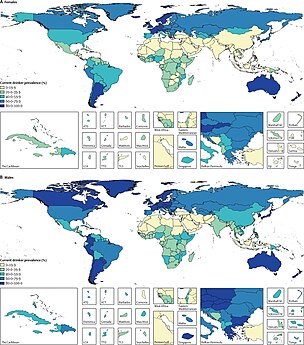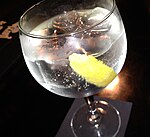Alcoholic beverage
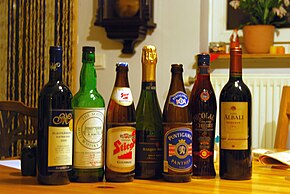
An alcoholic beverage (also called an adult beverage, alcoholic drink, strong drink, or simply a drink) is a drink that contains ethanol, a type of alcohol and is produced by fermentation of grains, fruits, or other sources of sugar.[1] The consumption of alcoholic drinks, often referred to as "drinking", plays an important social role in many cultures. Alcoholic drinks are typically divided into three classes—beers, wines, and spirits—and typically their alcohol content is between 3% and 50%.
Most countries have laws regulating the production, sale, and consumption of alcoholic beverages,[2] and the temperance movement advocates against the consumption of alcoholic beverages.[3] Regulations may require the labeling of the percentage alcohol content (as ABV or proof) and the use of a warning label. Some countries ban the consumption of alcoholic drinks, but they are legal in most parts of the world. The global alcoholic drink industry exceeded $1.5 trillion in 2017.[4] Alcohol is one of the most widely used recreational drugs in the world, and about 33% of all humans currently drink alcohol.[5] In 2015, among Americans, 86% of adults had consumed alcohol at some point, with 70% drinking it in the last year and 56% in the last month.[6] Several other animals are affected by alcohol similarly to humans and, once they consume it, will consume it again if given the opportunity, though humans are the only species known to produce alcoholic drinks intentionally.[7]
Alcohol is a depressant, which in low doses causes euphoria, reduces anxiety, and increases sociability. In higher doses, it causes drunkenness, stupor, unconsciousness, or death. Long-term use can lead to an alcohol use disorder, an increased risk of developing several types of cancer, cardiovascular disease, and physical dependence. According to the World Health Organization, alcohol is in the highest risk-group carcinogen, and no quantity of its consumption can be considered safe.[8]
History[edit]
Prehistory[edit]
Discovery of late Stone Age jugs suggests that intentionally fermented drinks existed at least as early as the Neolithic period.[9]
The oldest verifiable brewery has been found in a prehistoric burial site in a cave near Haifa in modern-day Israel. Researchers have found residue of 13,000-year-old beer that they think might have been used for ritual feasts to honor the dead. The traces of a wheat-and-barley-based alcohol were found in stone mortars carved into the cave floor.[10]
Ancient period[edit]
Beer was likely brewed from barley as early as the 13,000 years ago in the Middle East.[11] Pliny the Elder wrote about the golden age of winemaking in Rome, the 2nd century BCE (200–100 BCE), when vineyards were planted.[12]
Examination and analysis of ancient pottery jars from the neolithic village of Jiahu in the Henan province of northern China revealed residue left behind by the alcoholic drinks they had once contained. According to a study published in the Proceedings of the National Academy of Sciences, chemical analysis of the residue confirmed that a fermented drink made of grape and hawthorn fruit wine, honey mead and rice beer was being produced in 7000–5600 BC (McGovern et al., 2005; McGovern 2009).[13][14] The results of this analysis were published in December 2004.[15]
The earliest evidence of winemaking was dated at 6,000 to 5,800 BCE in Georgia in the South Caucasus.[16]
Celtic people were known to have been making types of alcoholic cider as early as 3000 BC.[17][18] and wine was consumed in Classical Greece at breakfast or at symposia, and in the 1st century BC.[19]
Medieval period[edit]
Medieval Middle East[edit]
Medieval Muslim chemists such as Jābir ibn Ḥayyān (Latin: Geber, ninth century) and Abū Bakr al-Rāzī (Latin: Rhazes, c. 865–925) experimented extensively with the distillation of various substances. The distillation of wine is attested in Arabic works attributed to al-Kindī (c. 801–873 CE) and to al-Fārābī (c. 872–950), and in the 28th book of al-Zahrāwī's (Latin: Abulcasis, 936–1013) Kitāb al-Taṣrīf (later translated into Latin as Liber servatoris).[20] 12th century: The process of distillation spread from the Middle East to Italy,[21] where distilled alcoholic drinks were recorded in the mid-12th century.[21]
Medieval Europe[edit]
In Italy, the works of Taddeo Alderotti (1223–1296) describe a method for concentrating alcohol involving repeated fractional distillation through a water-cooled still.[22] By the early 14th century, distilled alcoholic drinks had spread throughout the European continent.[21] Distillation spread to Ireland and Scotland no later than the 15th century, as did the common European practice of distilling "aqua vitae", primarily for medicinal purposes.[23]
Early modern period[edit]
in 1690, England passed "An Act for the Encouraging of the Distillation of Brandy and Spirits from Corn" [24] Alcoholic beverages played an important role in the Thirteen Colonies from their early days when drinking wine and beer at that time was safer than drinking water – which was usually taken from sources also used to dispose of sewage and garbage.[25] Drinking hard liquor was common occurrence in early nineteenth-century United States.[26]
The Whiskey Rebellion (also known as the Whiskey Insurrection) was a violent tax protest in the United States beginning in 1791 and ending in 1794 during the presidency of George Washington. The so-called "whiskey tax" was the first tax imposed on a domestic product by the newly formed federal government. Beer was difficult to transport and spoiled more easily than rum and whiskey.
Modern period[edit]
The Rum Rebellion of 1808 was a coup d'état in the then-British penal colony of New South Wales, staged by the New South Wales Corps in order to depose Governor William Bligh. Australia's first and only military coup, its name derives from the illicit rum trade of early Sydney, over which the 'Rum Corps', as it became known, maintained a monopoly. During the first half of the 19th century, it was widely referred to in Australia as the Great Rebellion.[27]The alcohol monopoly system has a long history in various countries, often implemented to limit the availability and consumption of alcohol for public health and social welfare reasons.
The alcohol monopoly was created in the Swedish town of Falun in 1850, to prevent overconsumption and reduce the profit motive for sales of alcohol. It later went all over the country in 1905 when the Swedish parliament ordered all sales of vodka to be done via local alcohol monopolies.[28] In 1894, the Russian Empire established a state monopoly on vodka, which became a major source of revenue for the Russian government.
Later in the nineteenth century opposition to alcohol grew in the form of the temperance movement, in the United States, United Kingdom, Canada, Scandinavia and India, and it eventually led to national prohibitions in Canada (1918 to 1920), Norway (spirits only from 1919 to 1926), Finland (1919 to 1932), and the United States (1920 to 1933), as well as provincial prohibition in India (1948 to present).[29]
Fermented drinks[edit]

Beer[edit]
Beer is a beverage fermented from grain mash. It is typically made from barley or a blend of several grains and flavored with hops. Most beer is naturally carbonated as part of the fermentation process. If the fermented mash is distilled, then the drink becomes a spirit. Beer is the most consumed alcoholic beverage in the world.[30]
Cider[edit]
Cider or cyder (/ˈsaɪdər/ SY-dər) is a fermented alcoholic drink made from any fruit juice; apple juice (traditional and most common), peaches, pears ("Perry" cider) or other fruit. Cider alcohol content varies from 1.2% ABV to 8.5% or more in traditional English ciders. In some regions, cider may be called "apple wine".[31]
Fermented water[edit]
Fermented water is an ethanol-based water solution with approximately 15-17% ABV without sweet reserve. Fermented water is exclusively fermented with white sugar, yeast, and water. Fermented water is clarified after the fermentation to produce a colorless or off-white liquid with no discernible taste other than that of ethanol.
Mead[edit]
Mead (/miːd/), also called hydromel, is an alcoholic drink made by fermenting honey with water, sometimes with various fruits, spices, grains, or hops. The alcoholic content of mead may range from as low as 3% ABV to more than 20%. The defining characteristic of mead is that the majority of the drink's fermentable sugar is derived from honey. Mead can also be referred to as "honeywine."
Pulque[edit]
Pulque is the Mesoamerican fermented drink made from the "honey water" of maguey, Agave americana. Pulque can be distilled to produce tequila or Mezcal.[32]
Rice wine[edit]
Rice wine is an alcoholic drink fermented and possibly distilled from rice, consumed in East Asia, Southeast Asia and South Asia. Sake, huangjiu, mijiu, and cheongju are popular examples of East Asian rice wine.
Wine[edit]

Wine is a fermented beverage most commonly produced from grapes. Wine involves a longer fermentation process than beer and often a long aging process (months or years), resulting in an alcohol content of 9%–16% ABV.
Sparkling wines such French Champagne, Catalan Cava or Italian Prosecco are also made from grapes, with a secondary fermentation.
Fruit wines are made from fruits other than grapes, such as plums, cherries, or apples.
Distilled beverages[edit]

Distilled beverages (also called liquors or spirit drinks) are alcoholic drinks produced by distilling (i.e., concentrating by distillation) ethanol produced by means of fermenting grain, fruit, or vegetables.[33] Unsweetened, distilled, alcoholic drinks that have an alcohol content of at least 20% ABV are called spirits.[34] For the most common distilled drinks, such as whisky (or whiskey) and vodka, the alcohol content is around 40%. The term hard liquor is used in North America to distinguish distilled drinks from undistilled ones (implicitly weaker). Brandy, gin, mezcal, rum, tequila, vodka, whisky (or wiskey), baijiu, shōchū and soju are examples of distilled drinks. Distilling concentrates the alcohol and eliminates some of the congeners. Freeze distillation concentrates ethanol along with methanol and fusel alcohols (fermentation by-products partially removed by distillation) in applejack.
Fortified wine is wine, such as port or sherry, to which a distilled beverage (usually brandy) has been added.[35] Fortified wine is distinguished from spirits made from wine in that spirits are produced by means of distillation, while fortified wine is wine that has had a spirit added to it. Many different styles of fortified wine have been developed, including port, sherry, madeira, marsala, commandaria, and the aromatized wine vermouth.[36]
Rectified spirit[edit]
Rectified spirit, also called "neutral grain spirit", is alcohol which has been purified by means of "rectification" (i.e. repeated distillation). The term neutral refers to the spirit's lack of flavor that would have been present if the mash ingredients had been distilled to a lower level of alcoholic purity. Rectified spirit also lacks any flavoring added to it after distillation (as is done, for example, with gin). Other kinds of spirits, such as whiskey, (or whisky) are distilled to a lower alcohol percentage to preserve the flavor of the mash.
Rectified spirit is a clear, colorless, flammable liquid that may contain as much as 95% ABV. It is often used for medicinal purposes. It may be a grain spirit, or it may be made from other plants. It is used in mixed drinks, liqueurs, and tinctures, and also as a household solvent.
Congeners[edit]
In the alcoholic drinks industry, congeners are substances produced during fermentation. These substances include small amounts of chemicals such as occasionally desired other alcohols, like propanol and 3-methyl-1-butanol, but also compounds that are never desired such as acetone, acetaldehyde and glycols. Congeners are responsible for most of the taste and aroma of distilled alcoholic drinks and contribute to the taste of non-distilled drinks.[37] It has been suggested that these substances contribute to the symptoms of a hangover.[38] Tannins are congeners found in wine in the presence of phenolic compounds. Wine tannins add bitterness, have a drying sensation, taste herbaceous, and are often described as astringent. Wine tannins adds balance, complexity, structure and makes a wine last longer, so they play an important role in the aging of wine.[39]
Amount of use[edit]
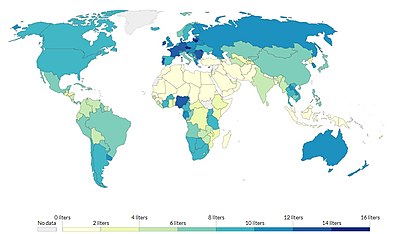

The average number of people who drink as of 2016[update] was 39% for males and 25% for females (2.4 billion people in total).[5] Females on average drink 0.7 drinks per day while males drink 1.7 drinks per day.[5] The rates of drinking varies significantly in different areas of the world.[5]
-
Age-standardised prevalence of current drinking for females (A) and males (B) in 2016, in 195 locations[5]
-
Average standard drinks (10 g of pure ethanol per serving) consumed per day, age-standardised, for females (A) and males (B) in 2016, in 195 locations[5]
Uses[edit]
[edit]
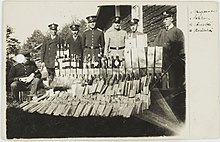
Alcohol is used in rum-running, the illegal business of smuggling alcoholic beverages where such transportation is forbidden by law.
Moonshine is illegal to produce and sell in most countries.
A straw purchaser may receive money or recompense from the underage person in exchange for purchasing the alcohol on their behalf.
Alcohol has been used as a currency for transactional sex in South Africa, and Uganda.[41][42][43]
Food[edit]
Apéritifs and digestifs[edit]
An apéritif is any alcoholic beverage usually served before a meal to stimulate the appetite,[44] while a digestif is any alcoholic beverage served after a meal for the stated purpose of improving digestion. Fortified wine, liqueurs, and dry champagne are common apéritifs. Because apéritifs are served before dining, they are usually dry rather than sweet. One example is Cinzano, a brand of vermouth. Digestifs include brandy, fortified wines and herb-infused spirits (Drambuie).
Cooking[edit]
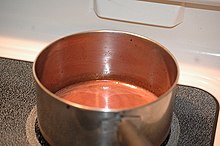
Pure ethanol tastes bitter to humans; some people also describe it as sweet.[45] However, ethanol is also a moderately effective solvent for many fatty substances and essential oils. This facilitates the use of flavoring and coloring compounds in alcoholic drinks as a taste mask, especially in distilled drinks. Some flavors may be naturally present in the beverage's raw material. Beer and wine may also be flavored before fermentation, and spirits may be flavored before, during, or after distillation. Sometimes flavor is obtained by allowing the beverage to stand for months or years in oak barrels, usually made of American or French oak. A few brands of spirits may also have fruit or herbs inserted into the bottle at the time of bottling.
Wine is important in cuisine not just for its value as an accompanying beverage, but as a flavor agent, primarily in stocks and braising, since its acidity lends balance to rich savory or sweet dishes.[46] Wine sauce is an example of a culinary sauce that uses wine as a primary ingredient.[47] Natural wines may exhibit a broad range of alcohol content, from below 9% to above 16% ABV, with most wines being in the 12.5–14.5% range.[48] Fortified wines (usually with brandy) may contain 20% alcohol or more.
Food preservative[edit]
Alcohol has been used to preserve food.[49]
This section needs expansion. You can help by adding to it. (March 2024) |
Drinking food[edit]
Terms for foods always served with alcoholic beverages:
- Anju -- Korean term for drinking food
- Kap klaem -- Thai term for drinking food
- Sakana -- Japanese term for snacks served while drinking
Vinegar production[edit]
Vinegar (vyn egre; sour wine) is an aqueous solution of acetic acid and trace compounds that may include flavorings. Vinegar typically contains from 5% to 18% acetic acid by volume.[50] Usually, the acetic acid is produced by a double fermentation, converting simple sugars to ethanol using yeast and ethanol to acetic acid using acetic acid bacteria.[51]
The source materials for making vinegar are varied – different fruits, grains, alcoholic beverages, and other fermentable materials are used:[52]
- Apple cider vinegar, or cider vinegar, is a vinegar made from cider.[53]
- Rice vinegar is a vinegar made from rice wine.
Wine and food matching[edit]
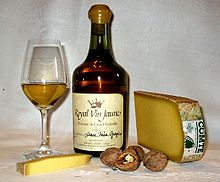
Wine and food matching is the process of pairing food dishes with wine to enhance the dining experience. In many cultures, wine has had a long history of being a staple at the dinner table and in some ways both the winemaking and culinary traditions of a region will have evolved together over the years. Rather than following a set of rules, local cuisines were paired simply with local wines. The modern "art" of food pairings is a relatively recent phenomenon, fostering an industry of books and media with guidelines for pairings of particular foods and wine. In the restaurant industry, sommeliers are often present to make food pairing recommendations for the guest. The main concept behind pairings is that certain elements (such as texture and flavor) in both food and wine interact with each other, and thus finding the right combination of these elements will make the entire dining experience more enjoyable. However, taste and enjoyment are very subjective and what may be a "textbook perfect" pairing for one taster could be less enjoyable to another.[54]
Offerings[edit]
Folk saints[edit]
Alcoholic beverages are typical offerings for the folk saints Maximón,[55] and Santa Muerte.[56][57] Both folk saints have been described as narco-saints.[58][59]
Religious[edit]
Libation[edit]
A libation is a ritual pouring of a liquid, or grains such as rice, as an offering to a deity or spirit, or in memory of the dead. It was common in many religions of antiquity and continues to be offered in cultures today. Wine or other alcoholic drinks are often used for libation.
Africa[edit]
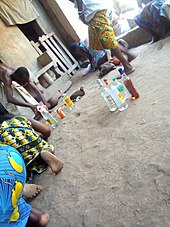
Libation was part of ancient Egyptian society where it was a drink offering to honor and please the various divinities, sacred ancestors, humans present and humans who are alive but not physically present, as well as the environment.[60] It is suggested that libation originated somewhere in the upper Nile Valley and spread out to other regions of Africa and the world.[61][62] According to Ayi Kwei Armah, "[t]his legend explains the rise of a propitiatory custom found everywhere on the African continent: libation, the pouring of alcohol or other drinks as offerings to ancestors and divinities."[63]
Americas[edit]
In the Quechua and Aymara cultures of the South American Andes, it is common to pour a small amount of one's beverage on the ground before drinking as an offering to the Pachamama, or Mother Earth. This especially holds true when drinking Chicha, an alcoholic beverage unique to this part of the world. The libation ritual is commonly called challa and is performed quite often, usually before meals and during celebrations. The sixteenth century writer Bernardino de Sahagún records the Aztec ceremony associated with drinking octli:
Libation was done in this manner: when octli was drunk, when they tasted the new octli, when someone had just made octli...he summoned people. He set it out in a vessel before the hearth, along with small cups for drinking. Before having anyone drink, he took up octli with a cup and then poured it before the hearth; he poured the octli in the four directions. And when he had poured the octli then everyone drank it.[64]
Sacramental wine in Christianity[edit]
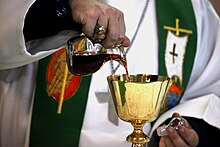
The amount of sacramental wine consumed during the Eucharist is typically limited to a single sip or small portion, which does not result in a measurable increase in the participant's blood alcohol content. This controlled and symbolic consumption of the sacramental wine is an integral part of the Eucharistic rite and does not lead to intoxication.
Catholic Church[edit]
According to the Catholic Church, the sacramental wine used in the Eucharist must contain alcohol. Canon 924 of the present Code of Canon Law (1983) states:
§3 The wine must be natural, made from grapes of the vine, and not corrupt.[65]
Lutheranism[edit]
In Lutheranism, the Catechism teaches:[66]
289. What are the visible elements in the Sacrament?
The visible elements are bread and wine.
935. Matt. 26:26-27 Jesus took bread … Then He took the cup.
Note: “The fruit of the vine” (Luke 22:18) in the Bible means wine, not grape juice. See also 1 Cor. 11:21[66]
Some Evangelical Lutheran Church in America (ELCA) congregations make grape juice available for children and those who are abstaining from alcohol and some will accommodate those with an allergy to wheat, gluten, or grapes.[67]
Tasting[edit]
Beer tasting[edit]
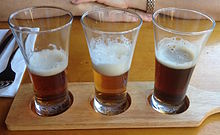
Beer tasting is a way to learn more about the history, ingredients, and production of beer, as well as different beer styles, hops, yeast, and beer presentation. A common approach is to analyze the appearance, smell, and taste of the beer, and then make a final judgment on the beer's quality. There are various scales used by beer journalists and experts to rate beer, such as the 1-20 scale used by British sommelier Jancis Robinson and the 1-100 scale used by American sommelier Joshua M. Bernstein. Professional organizations like the Wine & Spirit Education Trust often rate beer using verbal grades ranging from "faulty" to "outstanding" on a 1-5 scale.
Wine tasting[edit]
Wine tasting, on the other hand, is the sensory examination and evaluation of wine. While the practice of wine tasting is ancient, a more formalized methodology has been established since the 14th century. Modern, professional wine tasters use specialized terminology to describe the range of perceived flavors, aromas, and general characteristics of a wine. More informal, recreational tasting may involve similar terminology, but with a less analytical process and a more general, personal appreciation of the wine.
Tincture[edit]
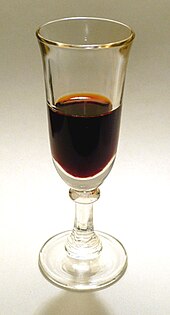
A tincture is typically an extract of plant or animal material dissolved in ethanol (ethyl alcohol). Solvent concentrations of 25–60% are common, but may run as high as 90%.[68] In chemistry, a tincture is a solution that has ethanol as its solvent. In herbal medicine, alcoholic tinctures are made with various ethanol concentrations, which should be at least 20% alcohol for preservation purposes.[68][69]
Other[edit]
Alcoholic beverage may be consumed to celebrate observances such as the International Beer Day, International whisk(e)y day, or National Vodka Day.
Alcohol measurement[edit]
Alcohol concentration[edit]
| Fruit juices | < 0.1% |
| Cider, wine coolers | 4%–8% |
| Beers | typically 5% (range is from 3–15%) |
| Wines | typically 13.5% (range is from 8%–17%) |
| Sakes | 15–16% |
| Fortified wines | 15–22% |
| Spirits | typically 30%-40% (range is from 15% to, in some rare cases, up to 98%) |
The concentration of alcohol in a beverage is usually stated as the percentage of alcohol by volume (ABV, the number of milliliters (ml) of pure ethanol in 100 ml of beverage) or as proof. In the United States, proof is twice the percentage of alcohol by volume at 60 degrees Fahrenheit (e.g. 80 proof = 40% ABV). Degrees proof were formerly used in the United Kingdom, where 100 degrees proof was equivalent to 57.1% ABV. Historically, this was the most dilute spirit that would sustain the combustion of gunpowder.
Ordinary distillation cannot produce alcohol of more than 95.6% by weight, which is about 97.2% ABV (194.4 proof) because at that point alcohol is an azeotrope with water. A spirit which contains a very high level of alcohol and does not contain any added flavoring is commonly called a neutral spirit. Generally, any distilled alcoholic beverage of 170 US proof or higher is considered to be a neutral spirit.[71]
Most yeasts cannot reproduce when the concentration of alcohol is higher than about 18%, so that is the practical limit for the strength of fermented drinks such as wine, beer, and sake. However, some strains of yeast have been developed that can reproduce in solutions of up to 25% ABV.[72]
Serving measures[edit]
Shot sizes[edit]
Shot sizes vary significantly from country to country. In the United Kingdom, serving size in licensed premises is regulated under the Weights and Measures Act (1985). A single serving size of spirits (gin, whisky, rum, and vodka) are sold in 25 ml or 35 ml quantities or multiples thereof.[73] Beer is typically served in pints (568 ml), but is also served in half-pints or third-pints. In Israel, a single serving size of spirits is about twice as much, 50 or 60 mL.
The shape of a glass can have a significant effect on how much one pours. A Cornell University study of students and bartenders' pouring showed both groups pour more into short, wide glasses than into tall, slender glasses.[74] Aiming to pour one shot of alcohol (1.5 ounces or 44.3 ml), students on average poured 45.5 ml & 59.6 ml (30% more) respectively into the tall and short glasses. The bartenders scored similarly, on average pouring 20.5% more into the short glasses. More experienced bartenders were more accurate, pouring 10.3% less alcohol than less experienced bartenders. Practice reduced the tendency of both groups to over pour for tall, slender glasses but not for short, wide glasses. These misperceptions are attributed to two perceptual biases:
- Estimating that tall, slender glasses have more volume than shorter, wider glasses; and
- Over-focusing on the height of the liquid and disregarding the width.
Standard drinks[edit]

There is no single standard, but a standard drink of 10g alcohol, which is used in the WHO AUDIT (Alcohol Use Disorders Identification Test)'s questionnaire form example,[75] have been adopted by more countries than any other amount.[76] 10 grams is equivalent to 12.7 millilitres.
A standard drink is a notional drink that contains a specified amount of pure alcohol. The standard drink is used in many countries to quantify alcohol intake. It is usually expressed as a measure of beer, wine, or spirits. One standard drink always contains the same amount of alcohol regardless of serving size or the type of alcoholic beverage. The standard drink varies significantly from country to country. For example, it is 7.62 ml (6 grams) of alcohol in Austria, but in Japan it is 25 ml (19.75 grams):
- In the United Kingdom, there is a system of units of alcohol which serves as a guideline for alcohol consumption. A single unit of alcohol is defined as 10 ml. The number of units present in a typical drink is sometimes printed on bottles. The system is intended as an aid to people who are regulating the amount of alcohol they drink; it is not used to determine serving sizes.
- In the United States, the standard drink contains 0.6 US fluid ounces (18 ml) of alcohol. This is approximately the amount of alcohol in a 12-US-fluid-ounce (350 ml) glass of beer, a 5-US-fluid-ounce (150 ml) glass of wine, or a 1.5-US-fluid-ounce (44 ml) glass of a 40% ABV (80 US proof) spirit.
Laws[edit]
Alcohol laws regulate the manufacture, packaging, labelling, distribution, sale, consumption, blood alcohol content of motor vehicle drivers, open containers, and transportation of alcoholic drinks. Such laws generally seek to reduce the adverse health and social impacts of alcohol consumption. In particular, alcohol laws set the legal drinking age, which usually varies between 15 and 21 years old, sometimes depending upon the type of alcoholic drink (e.g., beer vs wine vs hard liquor or distillates). Some countries do not have a legal drinking or purchasing age, but most countries set the minimum age at 18 years.[2]
Some countries, such as the U.S., have the drinking age higher than the legal age of majority (18), at age 21 in all 50 states. Such laws may take the form of permitting distribution only to licensed stores, monopoly stores, or pubs and they are often combined with taxation, which serves to reduce the demand for alcohol (by raising its price) and it is a form of revenue for governments. These laws also often limit the hours or days (e.g., "blue laws") on which alcohol may be sold or served, as can also be seen in the "last call" ritual in US and Canadian bars, where bartenders and servers ask patrons to place their last orders for alcohol, due to serving hour cutoff laws. In some countries, alcohol cannot be sold to a person who is already intoxicated. Alcohol laws in many countries prohibit drunk driving.
In some jurisdictions, alcoholic drinks are totally prohibited for reasons of religion (e.g., Islamic countries with sharia law) or for reasons of local option, public health, and morals (e.g., Prohibition in the United States from 1920 to 1933). In jurisdictions which enforce sharia law, the consumption of alcoholic drinks is an illegal offense,[77] although such laws may exempt non-Muslims.[78]
Alcohol and health[edit]
It has been suggested that this article be merged into Alcohol (drug). (Discuss) Proposed since March 2024. |
Alcohol is a depressant, which in low doses causes euphoria, reduces anxiety, and increases sociability. In higher doses, it causes drunkenness, stupor, unconsciousness, or death.
The short-term effects of alcohol consumption range from a decrease in anxiety and motor skills and euphoria at lower doses to intoxication (drunkenness), to stupor, unconsciousness, anterograde amnesia (memory "blackouts"), and central nervous system depression at higher doses. Cell membranes are highly permeable to alcohol, so once it is in the bloodstream, it can diffuse into nearly every cell in the body. Alcohol can greatly exacerbate sleep problems. During abstinence, residual disruptions in sleep regularity and sleep patterns are the greatest predictors of relapse.[79] Long-term use can lead to an alcohol use disorder, an increased risk of developing physical dependence. cardiovascular disease and several types of cancer. The International Agency for Research on Cancer lists ethanol in alcoholic beverages as a Group 1 carcinogen in humans and states that: "There is sufficient evidence and research showing the carcinogenicity of acetaldehyde (the major metabolite of ethanol) which is excreted by the liver enzyme when one drinks alcohol."[80] According to the World Health Organization, alcohol is in the highest risk-group carcinogen, and no quantity of its consumption can be considered safe.[8]

Some nations have introduced alcohol packaging warning messages that inform consumers about alcohol and cancer, as well as fetal alcohol syndrome.[81] The addition of warning labels on alcoholic beverages is historically supported by organizations of the temperance movement, such as the Woman's Christian Temperance Union, as well as by medical organisations, such as the Irish Cancer Society.[82][83]
A systemic metanalysis of 107 cohort studies concluded low daily alcohol intake gives neither harm nor benefit; however, increased consumption, even at relatively low levels of daily intake (>2 beverages for women and >3 beverages for men), does increase health and mortality risks.[84]
See also[edit]
- List of alcoholic drinks
- List of national drinks
- List of whisky brands
- List of rum brands
- List of tequilas
- List of vodka brands
- Liquor
- Beer and breweries by region
- List of barley-based drinks
- List of beer cocktails
- List of cocktails
- List of IBA official cocktails
- Beer and breweries by region
- Alcoholic beverage industry in Europe
- Alcohol (chemistry)
- Homebrewing
References[edit]
- ^ Cook, Christopher C. H. (4 May 2006). Alcohol, Addiction and Christian Ethics. Cambridge University Press. p. 95. ISBN 978-1-139-45497-1.
'Drunkenness', at least in popular usage, he considered to be equivalent to 'intoxication'. Intoxication in turn, again according to popular usage, was understood as referring to 'the aggravated symptoms of alcoholic poisoning'. While recognising that intemperance was, in fact, 'indicative of sensual indulgence in general', he stated that in 'popular usage' it had gradually become narrowed in meaning to 'indulgence of the appetite for Strong Drink' or 'indulgence in some alcoholic drink'.
- ^ a b "Minimum Legal Age Limits". IARD.org. International Alliance for Responsible Drinking. Archived from the original on 4 May 2016. Retrieved 23 June 2016.
- ^ Henry, Yeomans (18 June 2014). Alcohol and Moral Regulation: Public Attitudes, Spirited Measures and Victorian Hangovers. Policy Press. p. 244. ISBN 978-1-4473-0994-9.
- ^ a b Jernigan, D; Ross, CS (March 2020). "The Alcohol Marketing Landscape: Alcohol Industry Size, Structure, Strategies, and Public Health Responses". Journal of Studies on Alcohol and Drugs. Supplement. Sup 19 (Suppl 19): 13–25. doi:10.15288/jsads.2020.s19.13. PMC 7064002. PMID 32079559.
- ^ a b c d e f Griswold, Max G.; Fullman, Nancy; Hawley, Caitlin; Arian, Nicholas; Zimsen, Stephanie R M.; Tymeson, Hayley D.; Venkateswaran, Vidhya; Tapp, Austin Douglas; Forouzanfar, Mohammad H.; Salama, Joseph S.; Abate, Kalkidan Hassen; Abate, Degu; Abay, Solomon M.; Abbafati, Cristiana; Abdulkader, Rizwan Suliankatchi; Abebe, Zegeye; Aboyans, Victor; Abrar, Mohammed Mehdi; Acharya, Pawan; Adetokunboh, Olatunji O.; Adhikari, Tara Ballav; Adsuar, Jose C.; Afarideh, Mohsen; Agardh, Emilie Elisabet; Agarwal, Gina; Aghayan, Sargis Aghasi; Agrawal, Sutapa; Ahmed, Muktar Beshir; Akibu, Mohammed; et al. (August 2018). "Alcohol use and burden for 195 countries and territories, 1990–2016: a systematic analysis for the Global Burden of Disease Study 2016". The Lancet. 392 (10152): 1015–35. doi:10.1016/S0140-6736(18)31310-2. PMC 6148333. PMID 30146330.
- ^ "Alcohol Facts and Statistics". National Institute on Alcohol Abuse and Alcoholism. National Institute of Health. August 2018. Archived from the original on 18 May 2015. Retrieved 8 October 2018.
- ^ Zielinski, Sarah (16 September 2011). "The Alcoholics of the Animal World". Smithsonian. Archived from the original on 22 August 2015. Retrieved 29 July 2015.
- ^ a b "No level of alcohol consumption is safe for our health". www.who.int. Archived from the original on 2023-01-12. Retrieved 2023-01-12.
- ^ Patrick, Clarence Hodges (1952). Alcohol, Culture, and Society. Durham, NC: Duke University Press (reprint edition by AMS Press, New York, 1970). pp. 26–27. ISBN 978-0-404-04906-5.
- ^ "'World's oldest brewery' found in cave in Israel, say researchers". BBC News. 2018-09-15. Retrieved 2021-01-26.
- ^ Rosso AM (2012). "Beer and wine in antiquity: beneficial remedy or punishment imposed by the Gods?". Acta medico-historica Adriatica. 10 (2): 237–62. PMID 23560753.
- ^ Brostrom GG, Brostrom JJ (30 December 2008). The Business of Wine: An Encyclopedia: An Encyclopedia. ABC-CLIO. pp. 6–. ISBN 978-0-313-35401-4.
- ^ Chrzan, Janet (2013). Alcohol: Social Drinking in Cultural Context. Routledge. p. 13. ISBN 978-0-415-89249-0.
- ^ McGovern, P.E.; Zhang, J.; Tang, J.; Zhang, Z.; Hall, G.R.; Moreau, R.A.; Nunez, A.; Butrym, E.D.; Richards, M.P.; Wang, C.-S.; Cheng, G.; Zhao, Z.; Wang, C. (2004). "Fermented beverages of pre- and proto-historic China". Proceedings of the National Academy of Sciences. 101 (51): 17593–98. Bibcode:2004PNAS..10117593M. doi:10.1073/pnas.0407921102. PMC 539767. PMID 15590771.
- ^ Roach, John. "Cheers! Eight ancient drinks uncorked by science". Nbc News. Archived from the original on 4 April 2019. Retrieved 9 June 2013.
- ^ McGovern P, Jalabadze M, Batiuk S, Callahan MP, Smith KE, Hall GR, Kvavadze E, Maghradze D, Rusishvili N, Bouby L, Failla O, Cola G, Mariani L, Boaretto E, Bacilieri R, This P, Wales N, Lordkipanidze D (November 2017). "Early Neolithic wine of Georgia in the South Caucasus". Proceedings of the National Academy of Sciences of the United States of America. 114 (48): E10309–E10318. Bibcode:2017PNAS..11410309M. doi:10.1073/pnas.1714728114. PMC 5715782. PMID 29133421.
- ^ "The history and origins of cider". 13 February 2019. Archived from the original on 21 June 2021.
- ^ "The History of Cider". 25 April 2022. Archived from the original on 29 October 2022. Retrieved 29 October 2022.
- ^ Ancient Mashed Grapes Found in Greece Archived 3 January 2008 at the Wayback Machine Discovery News.
- ^ al-Hassan, Ahmad Y. (2009). "Alcohol and the Distillation of Wine in Arabic Sources from the 8th Century". Studies in al-Kimya': Critical Issues in Latin and Arabic Alchemy and Chemistry. Hildesheim: Georg Olms Verlag. pp. 283–298. (same content also available on the author's website Archived 2015-12-29 at the Wayback Machine); cf. Berthelot, Marcellin; Houdas, Octave V. (1893). La Chimie au Moyen Âge. Vol. I–III. Paris: Imprimerie nationale. vol. I, pp. 141, 143.
- ^ a b c Forbes, Robert James (1970). A Short History of the Art of Distillation: From the Beginnings up to the Death of Cellier Blumenthal. Brill. ISBN 978-90-04-00617-1. Archived from the original on 23 January 2023. Retrieved 28 June 2010.
- ^ Holmyard, Eric John (1957). Alchemy. Harmondsworth: Penguin Books. ISBN 978-0-486-26298-7. pp. 51–52.
- ^ Whiskey: Technology, Production and Marketing: Handbook of Alcoholic Beverages Series p2 Academic Press 2003
- ^ Preventing Alcohol Abuse: Alcohol, Culture, and Control By David J. Hanson page 3
- ^ "America's History of Drinking". Alcohol.org.
- ^ Garrison, James Holley (1954). "Introduction to Part I". In Merrill, Walter McIntosh (ed.). Behold Me Once More. The Confessions of James Holley Garrison, brother of William Lloyd Garrison. Boston: Houghton, Mifflin. p. 4.
- ^ "NOTABLE AUSTRALIAN EVENTS". The Sunday Times. No. 619. New South Wales, Australia. 7 November 1897. p. 9. Retrieved 25 February 2019 – via National Library of Australia.
- ^ Systembolaget.se About Systembolaget Archived 2007-10-18 at the Wayback Machine
- ^ Edman, Johan (September 2015), "Temperance and Modernity: Alcohol Consumption as a Collective Problem, 1885–1913", Journal of Social History, 49 (1): 20–52, doi:10.1093/jsh/shv029
- ^ Nelson, Max (2005). The Barbarian's Beverage: A History of Beer in Ancient Europe. Abingdon, Oxon: Routledge. p. 1. ISBN 978-0-415-31121-2. Archived from the original on 23 January 2023. Retrieved 21 September 2010.
- ^ Martin Dworkin, Stanley Falkow (2006). The Prokaryotes: Proteobacteria: alpha and beta subclasses. Springer. p. 169. ISBN 978-0-387-25495-1. Retrieved 29 July 2011.
- ^ Super, "Alcoholic Beverages", pp. 45–46.
- ^ "Distilled spirit/distilled liquor". Britannica. Archived from the original on 2008-05-09. Retrieved 2013-02-05.
- ^ Lichine, Alexis. Alexis Lichine's New Encyclopedia of Wines & Spirits (5th edition) (New York: Alfred A. Knopf, 1987), 707–709.
- ^ Lichine, Alexis (1987). Alexis Lichine's New Encyclopedia of Wines & Spirits (5th ed.). New York: Alfred A. Knopf. p. 236. ISBN 978-0-394-56262-9.
- ^ Robinson, J., ed. (2006). The Oxford Companion to Wine (3rd ed.). New York: Oxford University Press. p. 279. ISBN 978-0-19-860990-2.
- ^ Understanding Congeners in Wine Archived 2013-06-13 at the Wayback Machine, Wines & Vines. Accessed 2011-4-20
- ^ Whisky hangover 'worse than vodka, a study suggests' Archived 2023-01-23 at the Wayback Machine, BBC News. Accessed 2009-12-19
- ^ "The 5 Basic Wine Characteristics". Wine Folly. 2012-07-23. Archived from the original on 2015-03-15. Retrieved 6 May 2015.
- ^ "Alcohol consumption per person". Our World in Data. Archived from the original on 16 March 2020. Retrieved 15 February 2020.
- ^ Mihretie, GN; Kassa, BG; Ayele, AD; Liyeh, TM; Belay, HG; Miskr, AD; Minuye, B; Azanaw, MM; Worke, MD (2023). "Transactional sex among women in Sub-Saharan Africa: A systematic review and meta-analysis". PLOS ONE. 18 (6): e0286850. Bibcode:2023PLoSO..1886850M. doi:10.1371/journal.pone.0286850. PMC 10249834. PMID 37289839.
- ^ Miller, A. P.; Pitpitan, E. V.; Nabukalu, D.; Nalugoda, F.; Nakigozi, G.; Kigozi, G.; Grabowski, M. K.; Kennedy, C. E.; Wagman, J. A. (2021). "Transactional Sex, Alcohol Use and Intimate Partner Violence Against Women in the Rakai Region of Uganda". AIDS and Behavior. 25 (4): 1144–1158. doi:10.1007/s10461-020-03069-9. PMC 8807528. PMID 33128109.
- ^ Norris, AH; Kitali, AJ; Worby, E (October 2009). "Alcohol and transactional sex: how risky is the mix?". Social Science & Medicine (1982). 69 (8): 1167–76. doi:10.1016/j.socscimed.2009.07.015. PMID 19713023.
- ^ Caton, S.J.; Ball, M; Ahern, A; Hetherington, M.M. (2004). "Dose-dependent effects of alcohol on appetite and food intake". Physiology & Behavior. 81 (1): 51–58. doi:10.1016/j.physbeh.2003.12.017. PMID 15059684. S2CID 22424908.
- ^ Scinska, A; Koros, E; Habrat, B; Kukwa, A; Kostowski, W; Bienkowski, P (2000). "Bitter and sweet components of ethanol taste in humans". Drug and Alcohol Dependence. 60 (2): 199–206. doi:10.1016/s0376-8716(99)00149-0. PMID 10940547.
- ^ "6 Secrets of Cooking with Wine". Archived from the original on 2017-03-22. Retrieved 2017-04-12.
- ^ Parker, Robert M. (2008). Parker's Wine Buyer's Guide, 7th Edition. Simon and Schuster. p. 15. ISBN 978-1-4391-3997-4.
- ^ Jancis Robinson (2006). The Oxford Companion to Wine (3rd ed.). Oxford University Press. ISBN 978-0-19-860990-2. See alcoholic strength at p. 10.
- ^ "Ethanol as a food preservative". Retrieved 2024-04-21.
- ^ "Acetic acid: general information". GOV.UK. Government Digital Service. Retrieved 19 March 2024.
- ^ Nakayama, Takeyoshi (September 1959). "Studies on acetic acid-bacteria I. Biochemical studies on ethanol oxidation". The Journal of Biochemistry. 46 (9): 1217–1225. doi:10.1093/oxfordjournals.jbchem.a127022.
- ^ "Vinegar". TH Chan School of Public Health, Harvard University. 1 October 2019. Archived from the original on 14 November 2022. Retrieved 4 March 2020.
- ^ Ulbricht CE, ed. (2010). "Apple Cider Vinegar". Natural Standard Herb & Supplement Guide: An Evidence-Based Reference (1st ed.). Elsevier. p. 59. ISBN 978-0-323-07295-3.
- ^ K. MacNeil The Wine Bible pg 83-88 Workman Publishing 2001 ISBN 1-56305-434-5
- ^ Meet Maximón: The Liquor-Drinking, Chain-Smoking Saint, National Geographic, Bethany Jones, January 24th, 2018
- ^ Araujo Peña, Sandra Alejandro; Barbosa Ramírez Marisela; Galván Falcón Susana; García Ortiz Aurea; Uribe Ordaz Carlos. "El culto a la Santa Muerte: un estudio descriptivo" [The Santa Muerte Cult:A descriptive study]. Revista Psichologia (in Spanish). Mexico City: Universidad de Londres. Retrieved 2009-10-07.
- ^ Villarreal, Hector (2009-04-05). "La Guerra Santa de la Santa Muerte" [The Holy War of Santa Muerte]. Milenio semana (in Spanish). Mexico City: Milenio. Archived from the original on 2009-10-16. Retrieved 2009-10-07.
- ^ Vincent, Isabel (21 December 2021). "Santa Muerte and five more 'religious' saints worshiped by drug cartels". New York Post. Retrieved 10 June 2022.
- ^ Flannagin, Jake (September 2014). "The Rise of the Narco-Saints". The Atlantic. Retrieved 10 June 2022.
- ^ Nehusi, Kimani S.K. (2016). Libation. An Afrikan Ritual of Heritage in the Circle of Life. University Press of America. p. 14. ISBN 978-0-7618-6710-4.
- ^ Delia, 1992, pp. 181-190[full citation needed]
- ^ James, George G. M. (1954). Stolen Legacy. New York: Philosophical Library.
- ^ Armah, Ayi Kwei (2006). The Eloquence of the Scribes: a memoir on the sources and resources of African literature. Popenguine, Senegal: Per Ankh. p. 207.
- ^ Sahagún, Bernardino de; Nicholson, Henry B. (March 23, 1997). Primeros Memoriales. University of Oklahoma Press. ISBN 9780806129099 – via Google Books.
- ^ Code of Canon Law, 1983 Archived 2006-06-19 at the Wayback Machine
- ^ a b Weber, Karl (31 May 2013). "Fruit of Which Vine?". Steadfast Lutherans. Retrieved 18 April 2024.
- ^ An example of a church that does. See the "Sunday Worship" section on the "Welcome" page.
- ^ a b Groot Handboek Geneeskrachtige Planten by Geert Verhelst
- ^ Ullian, Naomi (2016-09-19). "How To Make A Medicinal Mushroom Double-Extraction Tincture". Herbal Academy. Retrieved 2021-01-12.
- ^ "Find the Alcohol Contents of Beer, Wine, and Liquor". Archived from the original on 2 May 2015. Retrieved 6 May 2015.
- ^ Lichine, Alexis. Alexis Lichine's New Encyclopedia of Wines & Spirits (5th edition) (New York: Alfred A. Knopf, 1987), 365.
- ^ Stewart, Graham G. "Biographical Review: Seduced by Yeast". Journal of the American Society of Brewing Chemists (2015): 1–21. American Society of Brewing Chemists. 21 Jan. 2015. Web. 14 May 2017.
- ^ "fifedirect – Licensing & Regulations – Calling Time on Short Measures!". Fifefire.gov.uk. 2008-07-29. Archived from the original on 2011-07-22. Retrieved 2010-02-11.
- ^ Wansink, Brian; van Ittersum, Koert (2005). "Shape of glass and amount of alcohol poured: comparative study of effect of practice and concentration". BMJ. 331 (7531): 1512–14. doi:10.1136/bmj.331.7531.1512. PMC 1322248. PMID 16373735.
- ^ "AUDIT The Alcohol Use Disorders Identification Test (Second Edition)" (pdf). WHO. 2001. Archived (PDF) from the original on 2022-01-20. Retrieved 2020-01-02.
- ^ Kalinowski, A.; Humphreys, K. (2016-04-13). "Governmental standard drink definitions and low-risk alcohol consumption guidelines in 37 countries". Addiction. 111 (7): 1293–8. doi:10.1111/add.13341. PMID 27073140.
- ^ Williams, Lizzie. Nigeria: The Bradt Travel Guide. p. 101.
- ^ Alcohol and Temperance in Modern History p. 329 David M. Fahey, Ian R. Tyrrell (2003)
- ^ Feige B, Scaal S, Hornyak M, Gann H, Riemann D (January 2007). "Sleep electroencephalographic spectral power after withdrawal from alcohol in alcohol-dependent patients". Alcoholism: Clinical and Experimental Research. 31 (1): 19–27. doi:10.1111/j.1530-0277.2006.00260.x. PMID 17207097.
- ^ Agents Classified by the IARC Monographs, Volumes 1–111 Archived 25 October 2011 at the Wayback Machine. monographs.iarc.fr
- ^ "Cancer warning labels to be included on alcohol in Ireland, minister confirms". Belfast Telegraph. 26 September 2018. Archived from the original on 11 April 2020. Retrieved 20 February 2023.
- ^ Chandler, Ellen (2012). "FASD - Fetal Alcohol Spectrum Disorder". White Ribbon Signal. 117 (2): 2.
- ^ Finn, Christina. "Irish Cancer Society urges minister not to drop proposed cancer warning labels on alcohol products". TheJournal.ie. Archived from the original on 2023-02-20. Retrieved 2023-02-20.
- ^ Bisognano, John (April 5, 2023). "Daily Alcohol Intake and Risk of All-Cause Mortality". American College of Cardiology.

